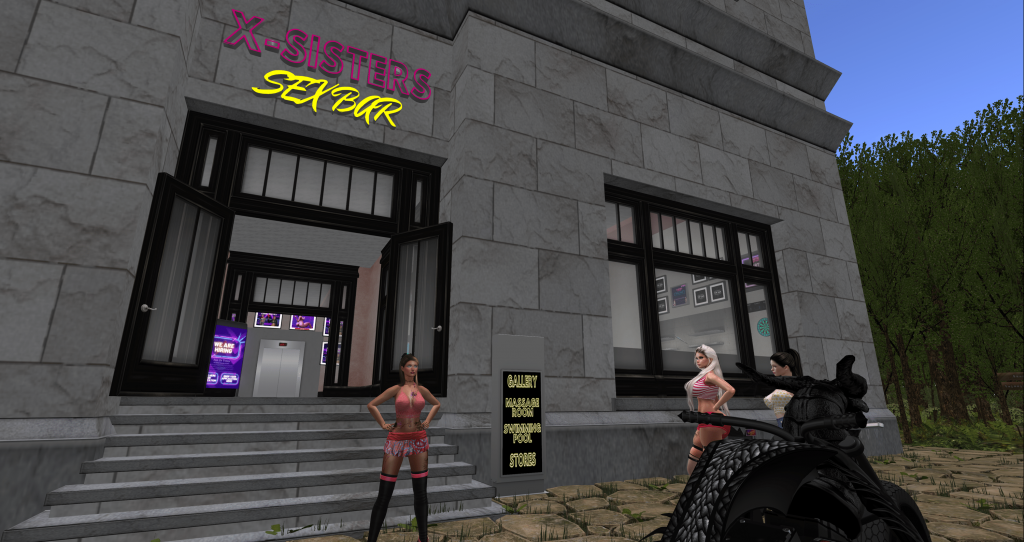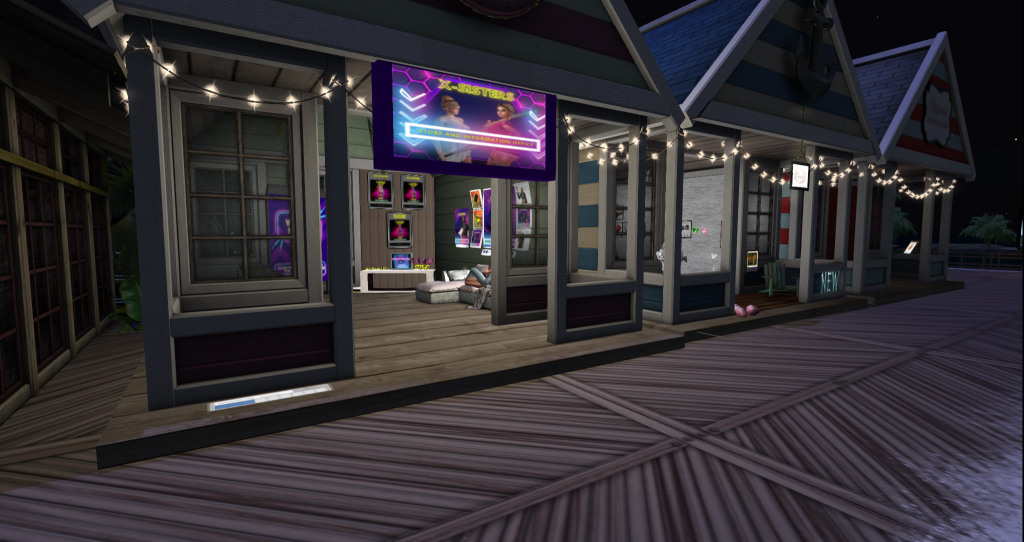Last Updated on: 20th January 2024, 02:44 pm
Second Life presents a unique platform for entrepreneurs, offering a virtual world rich with business opportunities. Something that I’ve been asked a few times is “How do I start a Second Life business?”. I have been fortunate enough to open, run, manage and grow my own virtual business. But it wasn’t easy and is only one of the ways to make money in Second Life. Some people think that all you have to do is buy land, pop up a building and people will come. This is the farthest thing from the truth. This guide aims to navigate you through the essentials of creating and managing a Second Life business in a virtual world environment. Whether that business is a store selling clothing, a marketplace selling furniture or in my case a combination of owning and running an escort venue alongside selling digital goods, the fundamentals are all the same.

Creating and Managing a Second Life Business | Laying the Groundwork
Starting a business venture in Second Life requires a solid foundation. This section is dedicated to helping you set up the fundamental aspects of your virtual business. From establishing a secure and effective utility account to understanding the nuances of land ownership and group management in Second Life, these initial steps are crucial for building a stable and successful enterprise. Whether you’re a seasoned entrepreneur or a newcomer to the virtual business world, this section will provide you with the essential knowledge and strategies to start your business journey on the right foot.
Utility Accounts in Second Life | Essentials
Creating a Utility Account is an essential step for any business. This account, separate from personal ones, serves as a cornerstone for your business’s virtual operations. It’s the key to managing various aspects of your enterprise, including transactions, group management, and land dealings.
A Utility Account in Second Life is more than just an account; it’s a tool that streamlines your business processes. It allows you to segregate your business activities from personal interactions, providing a professional and organized approach to managing your virtual presence. This account will be the central point for all your business-related activities in Second Life, acting as a hub for your entrepreneurial endeavours.
Security and access control are paramount when managing a Utility Account. It’s vital to ensure that only authorized people have access to this account to safeguard your business’s assets and operations. Regularly updating the account’s security settings and monitoring activity can prevent unauthorized access and potential security breaches.
Additionally, this account facilitates smoother interactions with other businesses and customers in Second Life. It allows for a more structured approach to transactions and collaborations, paving the way for a more efficient and effective business operation.
The process is easy. Create a new Second Life account dedicated to being a utility account.

Forming and Owning Groups for Business
In Second Life, forming and owning groups is a strategic tool for creating and managing a Second Life business. These groups serve as mini-communities within which you can organize and control various aspects of your business operations, from project management to customer interaction.
Creating a Group
To create a group in Second Life, you need to have a premium account and a small amount of Linden Dollars (L$) to pay the group creation fee. The process involves:
Naming Your Group: Choose a name that reflects your business identity and purpose. Once you name your group, you cannot ever change it so be sure you choose the right name.
Setting a Purpose: Define the group’s objective, whether it’s for internal management, customer engagement, or promotional activities. For example, at the X-Sisters Sex Bar we have two groups. Our main group which is where our customers are and where they can communicate. And our staff group which is internal communication only.
Determining Membership: Decide who can join the group. You can make it open for anyone to join, or by invitation only, depending on your business needs.
Managing Roles and Permissions
Within a group, you can assign different roles to members, each with specific permissions. These roles can range from administrative to more task-specific functions. For example, you might have roles such as ‘Manager,’ ‘Sales Representative,’ ‘Customer Service,’ etc. Each role can be customized with specific abilities, like the ability to send group notices, modify group land, or manage finances.
Benefits of Business Groups
Organizational Structure: Groups help in structuring your business by clearly defining roles and responsibilities.
Effective Communication: Send group notices or hold group meetings to keep members informed and engaged.
Control and Security: Assign permissions based on roles to maintain control and security over your business operations.
Collaboration and Networking: Foster collaboration among team members and network with customers or other businesses.
Marketing and Promotions: Utilize groups for marketing purposes, such as announcing new products or services, and hosting events or promotions.
Tips for Successful Group Management
Regularly review and update roles and permissions to align with changing business needs.
Engage actively with group members through regular updates and interactive discussions.
Monitor group activities to ensure they align with your business goals and community standards of Second Life.
Challenges and Solutions
Managing Large Groups: As your group grows, managing communication and activities can become challenging. Utilizing tools like group notices and having dedicated team members for group management can help.
Handling Conflicts: Conflicts might arise within groups. Establish clear guidelines and conflict resolution strategies to address any issues effectively.

Creating and Managing a Second Life Business | Land Ownership for Business Operations
Land ownership in Second Life is a pivotal aspect of creating and managing a Second Life business. It serves as the virtual foundation where your business activities take place, whether it’s for a retail store, office, event space, or even an escort venue.
Understanding Land Types in Second Life
Mainland vs. Private Islands: Mainland is a large, connected landmass managed by Linden Lab, while private islands are standalone pieces of land owned by individuals or entities. Mainland tends to be more affordable but may come with more neighbourhood variables, whereas private islands offer more control and privacy.
Buying vs. Renting: You have the option to buy or rent land. Buying land requires an upfront payment and ongoing tier fees to Linden Lab, but it offers more stability and control. Renting from another user can be more flexible and less costly upfront but may come with limitations set by the landowner.
Steps to Acquire Land for Business
Identify Your Business Needs: Determine the size and location that best suits your business. Consider factors like target audience, type of business, and budget.
Search for Available Land: Use the Second Life search function or visit land sales and rental regions to find available spaces.
Evaluate and Compare Options: Assess the land’s potential for your business, checking for traffic, neighbourhood, and any restrictions that might apply.
Make the Purchase or Rental Agreement: Once you’ve chosen a piece of land, follow the process to purchase or rent it. Ensure you understand all the terms, including any tier fees or rental rules.
Tips for Successful Land Management
Customize Your Space: Tailor your land to fit your brand and business needs. This might include building structures, setting up a storefront, or creating an immersive experience for visitors.
Optimize for Traffic: Attract visitors by optimizing your land for search keywords and participating in Second Life directories.
Monitor and Maintain: Regularly check your land for any issues or updates needed. Ensure it remains inviting and functional for your customers.
Challenges and Solutions
Managing Costs: Land ownership comes with costs, such as initial purchase fees and ongoing tiers. Budget wisely and consider starting small, then expanding as your business grows.
Dealing with Griefers: Griefers are users who might disrupt your business operations. Set appropriate land permissions and consider using security systems to mitigate this risk.

Creating and Managing a Second Life Business | Execution and Management
Transitioning from the planning stage to the execution and management phase is a critical juncture in creating and managing a Second Life business. This is where your Second Life business begins to take shape and come to life. In this section, we delve into the practical aspects of running your virtual enterprise. This includes crafting effective marketing strategies, managing finances, building a solid customer base, and navigating the legal and ethical landscapes of Second Life. These components are crucial for the day-to-day operations and long-term success of your business.
Marketing and Brand Development in Second Life
Developing a strong brand identity and implementing effective marketing strategies are super important for success in creating and managing a Second Life business. The virtual environment offers unique avenues for creative and impactful marketing that can significantly boost your brand’s visibility and appeal.
Building a Strong Brand Identity
Visual Identity: Create a distinct visual style for your brand, including logos, colour schemes, and design elements that reflect your business’s character.
Brand Story: Develop a compelling narrative about your business. What does your brand stand for? How does it add value to the Second Life community? At the X-Sisters Sex Bar, there is lore. And there’s a lot of lore about how it started, where it came from and what it’s designed for. A lot of that lore is here on this blog. This gets people invested and is such an important tool. It brings people in.
Consistency: Maintain consistency across all your virtual touchpoints – from your storefront and products to your advertising and customer service. Consistency reinforces brand recognition.
Innovative Marketing Strategies
Regular Updates and New Releases: Keep your audience engaged by regularly updating your offerings and introducing new products or services. This helps maintain interest and gives customers reasons to return.
Event Hosting: Organize in-world events, such as product launches, fashion shows, or themed parties, to draw attention and create a buzz around your brand.
Cross-Promotions and Collaborations: Partner with other Second Life businesses for cross-promotions or collaborative events. This can broaden your reach and introduce your brand to new audiences.

Keeping Marketing Fresh
I cannot add enough stress to this part. Never stagnate in what you do. Just because something works in the first doesn’t mean it’s always going to work. Be constantly coming up with ideas, and always put new things out there. Some will work, and some will fall flat on their face but always be doing something.
Innovation: Constantly brainstorm new marketing ideas. The virtual world is continually evolving, and so should your marketing strategies.
Adaptation: Pay attention to trends within Second Life and adapt your marketing to align with these trends. This shows that your brand is current and relatable.
Recycling Successful Campaigns: Take successful past marketing campaigns and reinvent them with a fresh spin. This can evoke nostalgia while showcasing your brand’s evolution.
Feedback and Engagement: Engage with your customers and solicit feedback. Use this input to tailor your marketing efforts and improve customer experiences.
Challenges in Marketing
Changing Trends: The virtual world’s trends can shift rapidly. Stay agile and be ready to adapt your marketing strategies to these changes.
Customer Attention Span: As virtual experiences are abundant, capturing and maintaining customer attention can be challenging. Create engaging, interactive, and value-added experiences to hold their interest.
Utilizing Second Life’s Features for Marketing
Billboards and Ad Spaces: Utilize advertising spaces within Second Life to promote your brand. Keep a spreadsheet of every board and track clicks, location, expiry date, cost. If you aren’t getting an average of 5 clicks per week per 100L then it’s not worth it.
Social Media Integration: Use social media platforms to extend your reach beyond Second Life, drawing in a broader audience.
In-world Groups and Forums: Engage with existing Second Life groups and forums related to your business niche for direct marketing and networking.

Creating and Managing a Second Life Business | Financial Management in Virtual Business
Effective financial management is a cornerstone of success when creating and managing a Second Life business. It involves not just tracking your earnings and expenditures but also setting realistic budgets, making informed investment decisions, and understanding the nuances of the virtual economy.
Setting Up a Financial Tracking System
Spreadsheet Management: Utilize spreadsheets to meticulously track all financial transactions, including sales, purchases, and overhead costs. Tools like Google Sheets or Microsoft Excel can be invaluable for this purpose.
Regular Reviews: Schedule regular times to review and update your financial records. This helps you stay on top of your financial situation and make informed decisions. For example, I do this every Monday morning. I look at the previous weeks’ income, staff hours, and what has been earned via tip jars versus drink sales. Hires vs small tips. Everything is valuable information.
Budgeting for Business
Setting a Budget: Establish a clear budget for different areas of your business, such as marketing, land rental or purchase, employee payments, and product development.
Adherence to Budget: Once your budget is set, stick to it. This discipline is crucial to avoid overspending and ensure financial stability.
Cost-Benefit Analysis: Regularly perform cost-benefit analyses for significant expenses. This includes evaluating the best value for money in advertising and other investments.
Pricing Strategies
Market Research: Conduct thorough market research to understand the pricing landscape in Second Life. This includes analyzing competitors’ pricing and understanding what customers are willing to pay.
Dynamic Pricing: Consider adopting dynamic pricing strategies where prices are adjusted based on market demand, competition, and other factors.
Special Offers and Discounts: Use special offers, discounts, or bundle deals to attract customers and boost sales, but ensure these are strategically planned and don’t hurt your bottom line.

Managing Revenue and Expenditures
Revenue Streams: Diversify your revenue streams where possible. This could include sales of products or services, rental income, or other creative revenue-generating activities within Second Life.
Expense Tracking: Keep a close eye on expenditures. This includes operational costs, marketing expenses, and any other costs associated with running your business.
Investing in Growth
Reinvesting Profits: Consider reinvesting a portion of your profits back into the business to fuel growth and expansion. This is a little-known fact about the X-Sisters Sex Bar. I don’t get any of the profits, everything that comes as a profit from the bar goes straight back into it. This is something that was set in stone from the minute we opened and it is why we continue to grow and why we have the best quality furniture and marketing in Second Life.
Smart Investments: Make smart investment decisions based on thorough research and potential return on investment. This could include investing in better virtual infrastructure, marketing campaigns, or product development.
Understanding the Virtual Economy
Currency Fluctuations: Be aware of the fluctuations in the value of Linden Dollars and how this might impact your business.
Quiet Periods: Know and expect quiet periods and reassure your staff that it will pass. Second Life can be really quiet at times and it will be worrying, but it’s not just your business. Everywhere will experience the lulls at the same time.

Creating and Managing a Second Life Business | Building and Managing a Customer Base
Building and managing a robust customer base is the most crucial aspect of creating and managing a Second Life business. It goes beyond just attracting customers; it involves cultivating lasting relationships, providing exceptional customer service, and creating a sense of community that resonates with them.
Attracting New Customers
Visibility in Second Life: Increase your visibility by positioning your business in high-traffic areas, participating in popular events, and engaging in Second Life’s various community platforms.
Targeted Marketing Campaigns: Develop marketing campaigns that speak directly to your ideal customer base. Utilize Second Life’s advertising platforms and social media integration to reach a wider audience.
First-Time Visitor Experience: Make a great first impression. Ensure that new visitors are greeted warmly and have a memorable experience, whether it’s through the design of your virtual space or the quality of customer interaction.
Engaging with Your Audience
Customer Interaction: Regularly interact with your customers through in-world chats, group messages, and by hosting interactive events. Personal interactions can significantly enhance customer loyalty.
Feedback Mechanisms: Implement mechanisms to gather customer feedback, such as surveys or suggestion boxes. Show your customers that their opinions are valued and considered in your business decisions.
Exclusive Offers and Rewards: Create exclusive offers, discounts, or even exciting challenges for your regular customers. This not only incentivizes repeat visits but also makes customers feel valued and appreciated.
Creating a Community Around Your Brand
Social Groups: Utilize Second Life’s group feature to create a community around your brand. This can be a platform for announcements, special events, and fostering discussions among customers.
Events and Gatherings: Regularly host events, workshops, or gatherings that align with your brand and interest your customer base. This helps in building a sense of community and belonging.
Innovative Use of Virtual Space: Use your virtual space innovatively to create experiences that bring people together, whether it’s through interactive displays, games, or themed areas.

Providing Excellent Customer Service
Responsive Support: Offer prompt and helpful customer service. This includes being available to answer questions, resolve issues, and provide guidance as needed.
Trained Staff: If you have staff, ensure they are well-trained in customer service and knowledgeable about your products or services.
Personalized Service: Whenever possible, personalize your service. Remembering customer preferences or details can make a significant difference in customer experience.
Building Long-Term Relationships
Regular Communication: Keep in touch with your customers through newsletters, group notices, or personal messages. Regular communication keeps your brand top-of-mind.
Appreciation and Recognition: Show appreciation for your customers. This could be as simple as thanking them for their business or recognizing them in your community groups.
Adapting to Customer Needs: Be adaptable to changing customer needs and preferences. Stay attuned to what your customers are looking for and evolve your offerings accordingly.
FAQs on Creating and Managing a Second Life Business
How Easy Is It to Start a Business in Second Life?
Starting a business in Second Life is relatively straightforward. There are no licenses, local taxes, shipping, or warehousing costs involved. All you need is a product or service and a platform to sell it, such as the Second Life Marketplace, which charges a 5% commission on sales
What Are Some Key Strategies for Success in Second Life Business?
The key to success is finding a niche and not competing with the masses. Collaborate with a team that brings together diverse talents like scripting, marketing, and design. Focus on offering something genuinely new and hard to emulate.
What Costs Are Involved in Setting Up a Typical Work Environment in Second Life?
For a private region, also known as an “island,” the initial setup fee is approximately $349 USD, with a monthly maintenance cost of around $229 USD per region. This space can then be developed for various business purposes.
How Many Avatars Can Participate in a Second Life Business Environment?
A single region can optimally support around 60 avatars before performance is affected, with a maximum limit of 100 avatars. For larger gatherings, using multiple regions or streaming the event live to the web are effective solutions.
What Unique Advantages Does Second Life Offer for Businesses?
Second Life stands out as a 3D virtual world that’s both easy and inexpensive to create immersive environments. It’s widely used for various purposes, including meetings, training sessions, simulations, and prototypes, making it a versatile platform for businesses and educational institutions.

Upcoming Business Workshop
After a few discussions with Daria, we have decided to branch out and start running business workshops. These will be aimed at people looking to start up their Second Life business and will take you through step-by-step processes for how to set up and run things smoothly. We will hold small workshops on marketing, financials, customer retention and more.
We are currently in the process of deciding where to hold these, the plan is either on PleasureScape land or on X-Sisters land but once we have all of those logistics set up and fine-tuned we will be ready to launch. So keep your eyes peeled for that!
In the meantime, my business is always there for you to visit. If you’re looking for an escort, you’re an escort looking for a place to work or if you’re looking to buy something like a chest stroker then stop by and take a look. Here’s your taxi.
Subscribe to get all the latest posts straight to your email!



Pingback: Just Like Second Life | A Wild Start to the Year
Pingback: Growing Your Second Life Blog | Jess’ Guide
You helped me a lot with this post. I love the subject and I hope you continue to write excellent articles like this.